| The Daily Show With Jon Stewart | Mon – Thurs 11p / 10c | |||
| George Lucas | ||||
| www.thedailyshow.com | ||||
|
||||
The radical notion that women like good movies
| The Daily Show With Jon Stewart | Mon – Thurs 11p / 10c | |||
| George Lucas | ||||
| www.thedailyshow.com | ||||
|
||||
The festival, created by Melissa Silverstein of Women and Hollywood and Kathryn Kolbert of the Athena Center for Leadership Studies at Barnard College, highlights women in film–whether behind or front of the camera, in writing, editing, and promotion. According to the site:
The Festival will highlight the wide diversity of women’s leadership in both real life and the fictional world, illuminating the stories of women from across the globe who have made a difference in their countries and communities. Our goal is to open a robust dialogue about women and leadership: what it takes to excel, collaborate, lead, and inspire.
This post by Stephanie Rogers first appeared at Bitch Flicks in March 2009.
Rule #1Sharing fun, challenging and intellectually engaging activities can strengthen friendships.
The point is: Male friendships need not solely revolve around sports and beer. In fact, in today’s movie world, those guys are the losers to be mocked and avoided.
Rule #2Friends are optimists, not naysayers.
The point is: No one likes to be around negative energy. If the dude doesn’t like Bob Marley, tell him “peace out” and move on.
Rule #3Friends carry each other.
Rule #4Friends accept friends for how they are. Even when alerting the authorities might be the more prudent call.
The point is: If your friends are 40 years old and still living at home (Step Brothers), don’t try to change them. Buy them a case of Fruit Roll-Ups instead. If your buddy is a heavily medicated mall cop looking to join the police force (Seth Rogen’s upcoming Observe and Report), you pat him on the head and hand him some pepper spray. And if your wingman gets a fake ID with the name McLovin on it — well, you can tell him he’s an idiot — but then you ask him to go score some beer.
Rule #5Friends make an effort to stay in touch.
The point is: … You don’t wait for buddies to call you. You pick up the phone. Or better: Just show up on their doorstep.
Rule #6Friends remain equally loyal in good times and bad.
Rule #7Friends know it’s OK to say, “I love you.” But they don’t have to, you know, talk about it at length.
The point is: These days in movies, male friendship means never having to say anything more than “I love you, man.”
 How many movies actually pass the test?
How many movies actually pass the test?
Thanks to Unapologetically Female for cuing us in!
 |
| WALL-E (2008) |
 |
| WALL-E “dating” EVE |
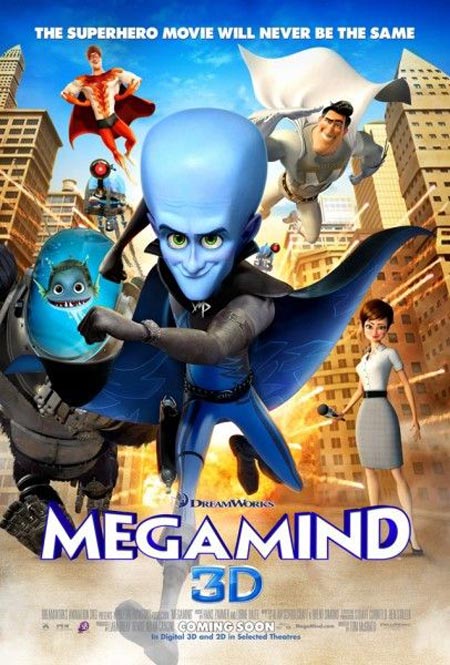 |
| Megamind (2010) |
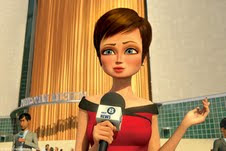 |
| Roxanne Ritchi, voiced by Tina Fey |
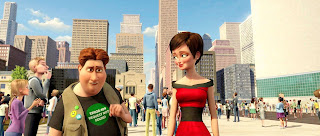 |
| Hal and Roxanne |
 |
| Shrek (2001) |
 |
| Artwork by William Steig |
 |
| Fiona, imagined by Dreamworks |
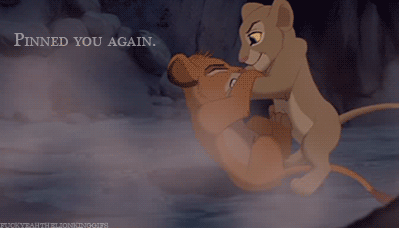 |
| Nala to Simba: “Pinned you again.” |
I should say first, let’s throw the whole “But this is how lions act” argument out the window. Lions are not actually “kings” of all animals; they do not actually get along with prey when they’re feeling like singing a song, or learn to eat bugs from them; when (male) lions become subadults, they have to leave their pride, and no, they can never come back. Etc., etc., etc.
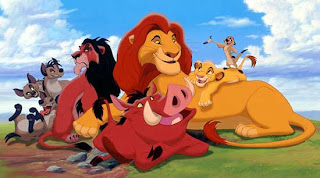 |
| One big, happy family? |
When it comes to Nala, her role has always frustrated me a lot. Ignoring that it might not work with the plot already in place, it was quite disappointing that Nala did not take over partially or fully in Simba’s absence. She is always shown, especially early on in the film, to be Simba’s equal, and she is perhaps even more intelligent, or at least a more naturally sound leader throughout the film, while Simba tends to be comparatively a bit more immature and in need of multiple characters propelling him into responsible/rightful action. This isn’t a critique of Simba’s likeability or abilities, but merely to say that in all aspects, Nala would have made at least a decent fill-in.
 |
| Simba and the more cunning Nala |
She comes up with better ideas then he does. She is the one who starts Simba thinking about his past and his future. Yet, despite the fact that she left the pride lands to find help, she also does not challenge Scar’s right to rule. She does little more than Sarabi to work toward getting a better life for herself and the other lionesses, only leaving the pride lands to seek help (read: a different male lion). Only when Simba returns to the lionesses stand up to Scar. This is because a new male has been found to lead them. The lionesses are very much kept in the shadow of the male lions.
I think this is really one of the main and most problematic aspects of the film: it basically boils down to the fact that an entire group of strong female characters are unable to confront a single male oppressor; to do so, they need to be led by a dominant male. It almost sucks more that Nala is such a strong, independent, intelligent, savvy female character and still ends up constrained by this plot device. It doesn’t say a lot of positive things about the role of women or about the importance of female characters in this film.
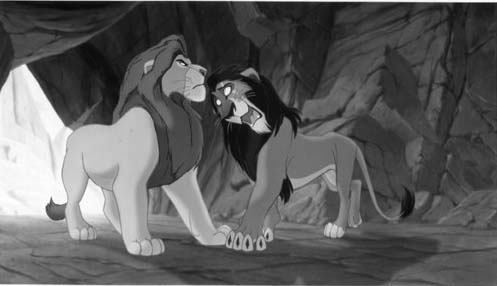 |
| Scar: Simba’s evil gay uncle? |
The characters are animals, but their voices show racist stereotypes. Even though The Lion King takes place in Africa, two white American actors are used for the voice of Simba, the hero. However, the hyenas who are bad characters in the film, speak non-standard English and are played by actors like Whoopi Goldberg and Cheech Marin. The villain, Scar, suggests homosexuality.
Many critics saw a racial subtext to the villainous outsiders, noting that the racialized voices of the hyenas hewed to hackneyed stereotypes of African American and Hispanic threats to nice kids from the suburbs who stray too far from home.
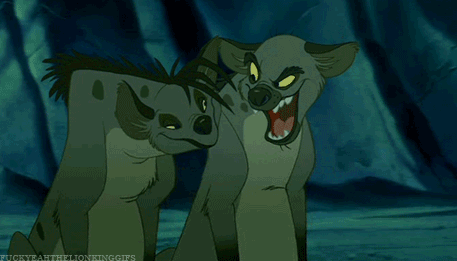 |
| Racialized hyenas? |
 |
| Disney’s Mulan (1998) |
If you watch the actual movie, as I did, as a European expat teaching in a Hong Kong international school and grappling with cross-cultural questions on a daily basis (you try teaching A Bridge To Terabithia to a class of city-dwelling Chinese boys) — not so much. Mulan has always been a problematic text for me because it tries so hard to be culturally sensitive and gender-aware that it positively creaks, and those creaks can be heard by the least-savvy member of the target audience. Its sins are not the sins of historical omission of, say, Snow White or Sleeping Beauty, but are all the more egregious because they come from a place of awareness. Mulan is an attempt to fix something that was perceived to be, if not wrong, unbalanced. This clumsy attempt to wedge The Ballad of Mulan into the rigid, alien form of a Disney narrative (which, among other things, demands musical numbers, a comic sidekick and a Prince Charming to come home with at the end) doesn’t fix anything, and only serves to remind us what is broken about our global culture. The road to hell is, as ever, paved with good intentions, particularly when it heads from the West to the East.
Back in the mid-1990s, Disney had a very specific agenda when it came to China. They wanted to get back into the regime’s good books after the PR disaster that was Kundun. They wanted to replicate the success of 1994’s The Lion King in the region. And they wanted to soften up the government and local politicians when it came to breaking ground on Hong Kong Disneyland, and paving the way for the Shanghai park. What better way to win friends and influence people than by honoring a popular Chinese legend in the form of a Disney film?
So, ever mindful of the accusations of racial insensitivity that had been tossed at Aladdin and Pocahontas, and anxious to get it right this time, Disney sent key artists on the movie to China, for a three-week tour of Chinese history and culture. Three weeks! You can totally “do China” in three weeks. This was enough to give them all the visual reference points they needed, and the whistle-stop, touristic nature of their impressions is very much in evidence on the screen. Every Chinese guided tour cliché is tossed into the scenery hotchpotch, from limestone mountains to the Great Wall to the Forbidden City. This isn’t so bad – other Disney movies are set in a vague Mittel-Europe of mountains, forests and lakes – but the loving attention paid to trotting out the visual truisms of courtyard complexes, brush calligraphy, cherry blossoms et al is just window-dressing. Mulan does look like China, but only if you’re leafing through your holiday photos back in your Florida office.
It’s a shame the screenwriters weren’t sent on the same tour. Mulan is peppered with crass jokes about Chinese food orders (because that’s what Americans can relate to about Chinese culture, right?), disrespectful references to ancestor worship, superficial homage to Buddhist practice and some kung-fu styling, of the Carradine kind. Given that Wu Xia is a rich, diverse, centuries old storytelling tradition, it also seems a shame that the writers didn’t draw more deeply on those perspectives. Instead, they send Mulan on a tired, Western Hero’s Journey, plugging her variables into the 12-step formula tried and tested by countless Hollywood protagonists. She doesn’t ever think like a Chinese woman. She’s never more American than when her rebellious individualism (bombing the mountaintop) wins the day – her filial obedience was only ever lip service paid as a convenience in Act One. Even in Han Dynasty China, it seems, it’s best to follow the American Way.
There’s nothing particularly Chinese about Mulan herself, who is so brutally meant to be not-Disney Princess and not-Caucasian it hurts to look at her for long. Poor little Other. She’s shown wearing Japanese make up, and has a facial structure more suggestive of Vietnamese than Chinese (Disney really was embracing post-colonialism). For half the movie, she also has to be not-female. The lack of detail on a 2-D Disney face meant the animators had to design her as able to switch between genders via her hair – and something subtle going on with her eyebrows. The resulting face evokes, more than anything, a pre-op kathoey who hasn’t yet taken advantage of Thailand’s booming plastic surgery clinics in order to make zer gender-reassignment complete.
Oh, Mulan. She’s meant to be non-offensive, and she ends up being not-anything. Despite claims to the contrary, she’s not a feminist hero. She has to dress as a boy to achieve selfhood, and refuses political influence in order to return to the domestic constraints of her father and husband-to-be. The movie itself doesn’t even pass the Bechdel test, if you consider that the only topic the other female characters discuss is Mulan’s marriageability – a hypothetical relationship with a man. The final defeat of the antagonist is achieved by the male Mushu riding on a phallic firecracker, as Mulan flails helplessly at his feet. Positive female role model? Case closed.
Nonetheless, Mulan did brisk business worldwide – apart from in China. It perhaps had most impact on second or third-gen Asian-Americans, who could relate to the over-simplified view of China, and feel a connection with this stereotypical version of “their” culture, lacking many other reference points. For Asian-Americans across the board, not just Chinese-Americans, Mulan’s brown, angular features represented something vaguely familiar, which made a delightful change. For Chinese-Chinese, Mulan was a thoughtless Western blunder. For Asian-Americans, particularly little girls, Mulan was a rare screen representation of aspects of their selves. Mulan drove the story, at the center of almost every scene, instead of pushed to the periphery as a “typical Asian” shopkeeper, geek, or whore. They could even purchase Mulan merch – although it’s still impossible to buy a doll, a t-shirt or a pin showing Mulan in warrior mode, she’s always got her hair down, and is wearing her hanfu frock. For a generation of Twinkies, Asian on the outside, American on the inside, Mulan was significant, a role model in the Disney pantheon of princesses. It didn’t matter that she was a bit low-rent (no castle, not really a princess), and she hadn’t snagged a proposal by the end of the movie (that happily ever after is a ‘maybe’), she allowed Asian-American girls, many of them adopted, to hold their heads high. And for that alone, you have to love her.
Mulan wouldn’t seem like such a frustrating, failed attempt to push gender and cultural boundaries if it had been followed up by other stories of empowered female warrior heroes. A Disney version of Joan of Arc or Boudicca could have been a blast. Unfortunately, since 1998, it’s been pretty much princess as usual. On the bright side, Disney achieved some of their other goals with Mulan. Hong Kong Disneyland (itself the subject of accusations of crass cultural insensitivity) has been doing brisk business since 2005, thanks to a US$2.9billion investment by Hong Kong taxpayers (of which I was one). The majority of tourists are from mainland China. They come to marvel at Western icons like Mickey, and an all-American Main Street that’s a replica of the one in Anaheim. Thanks to the ubiquitous presence of Mulan images, they stick around. It feels a tiny bit more like they might have a stake in the happiest place on earth.
There’s something else, though, that I can’t not notice about the NYT article: In the entire 1,187-word article, only about 200 words (3 paragraphs) were devoted to one of the highest honors and most controversial moments of the night: Oprah Winfrey winning the Jean Hersholt Humanitarian Award. She’s the first Black woman to win the award (Quincy Jones won in 1995, the only Black man to win it), yet her win has been called “boneheaded” and “a shameless bid for a ratings boost,” largely because her contributions to the film industry are seen by insiders as lacking.